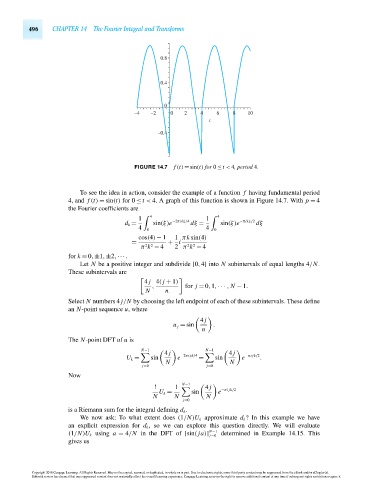Page 516 - Advanced engineering mathematics
P. 516
496 CHAPTER 14 The Fourier Integral and Transforms
0.8
0.4
0
–4 –2 0 2 4 6 8 10
t
–0.4
FIGURE 14.7 f (t) = sin(t) for 0 ≤ t < 4, period 4.
To see the idea in action, consider the example of a function f having fundamental period
4, and f (t) = sin(t) for 0 ≤ t < 4. A graph of this function is shown in Figure 14.7. With p = 4
the Fourier coefficients are
1 4 1 4
d k = sin(ξ)e −2πikξ/4 dξ = sin(ξ)e −πikξ/2 dξ
4 0 4 0
cos(4) − 1 1 πk sin(4)
= + i
π k − 4 2 π k − 4
2 2
2 2
for k = 0,±1,±2,···.
Let N be a positive integer and subdivide [0,4] into N subintervals of equal lengths 4/N.
These subintervals are
4 j 4( j + 1)
, for j = 0,1,··· , N − 1.
N n
Select N numbers 4 j/N by choosing the left endpoint of each of these subintervals. These define
an N-point sequence u, where
4 j
u j = sin .
n
The N-point DFT of u is
N−1 N−1
4 j 4 j
U k = sin e −2πijk/4 = sin e −πijk/2 .
N N
j=0 j=0
Now
N−1
! 1 4 j
U k = sin e −πijk/2
N N N
j=0
is a Riemann sum for the integral defining d k .
We now ask: To what extent does (1/N)U k approximate d k ? In this example we have
an explicit expression for d k , so we can explore this question directly. We will evaluate
N−1
(1/N)U k using a = 4/N in the DFT of [sin( ja)] j=0 determined in Example 14.15. This
gives us
Copyright 2010 Cengage Learning. All Rights Reserved. May not be copied, scanned, or duplicated, in whole or in part. Due to electronic rights, some third party content may be suppressed from the eBook and/or eChapter(s).
Editorial review has deemed that any suppressed content does not materially affect the overall learning experience. Cengage Learning reserves the right to remove additional content at any time if subsequent rights restrictions require it.
October 14, 2010 16:43 THM/NEIL Page-496 27410_14_ch14_p465-504

